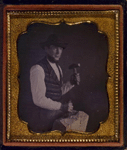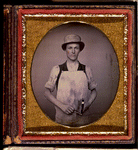
Photographer unidentified. [Occupational portrait of an unidentified stonecutter, three-quarters length, three-quarters to the right, holding mallet and chisel against block of stone] sixth plate daguerreotype, between 1850 and 1860.
| Daguerreotypes Home Page | Mirror Images: Daguerreotypes at the Library of Congress |
| PREVIOUS: American Colonization Society | NEXT: Architectural Scenes and Outdoor Views |
 Photographer unidentified. [Occupational portrait of an unidentified stonecutter, three-quarters length, three-quarters to the right, holding mallet and chisel against block of stone] sixth plate daguerreotype, between 1850 and 1860. |
Occasionally daguerreotypes document American laborers in the mid-nineteenth century. The subjects of occupational daguerreotypes pose with the tools of their trade or goods that they have made. Most occupational daguerreotypes depict tradesmen, such as cobblers, carpenters, and blacksmiths. |
| The unidentified subject of this daguerreotype sits behind an industrial model Grover and Baker sewing machine. Whether originally produced as a promotion for the machine's manufacturer, an illustration of the clothing industry at the time, or a portrait of a proud seamstress displaying the tools of her trade, this daguerreotype is one of the few surviving visual documents of working women in the United States before the Civil War. |  Photographer unidentified. [Occupational portrait of a woman working at a sewing machine] sixth plate daguerreotype, ca. 1853. |
 Photographer unidentified. [Occupational portrait of a watchmaker, three-quarters length, seated at table with watches] sixth plate daguerreotype, between 1840 and 1860. |
The watchmaker in this daguerreotype looks proudly toward the camera, almost as if he had just glanced up from his work to find the daguerreotypist ready to take his portrait. Most likely, this daguerreotype was made in the photographer's studio, with the sitter bringing his delicate tools and watches along with him for the portrait. |
| The railroad revolutionized transportation and enabled products to be delivered to new markets. This daguerreotype is accompanied by a poignant note: "Jacob Lewis Davis, my dear father. Taken when he worked on the railroad. He is the tall man with a beard standing on the left end." |  Photographer unidentified. [Occupational portrait of three railroad workers standing on hand propelled railroad cart] sixth plate daguerreotype, between 1850 and 1860. |
 Photographer unidentified. [Occupational portrait of a latch maker] sixth plate daguerreotype, between 1850 and 1860. |
Nineteenth-century paintings, prints, and illustrations of the American working class often presented idealized and heroicized images. In contrast, this daguerreotype of a locksmith with his scrawny arms, grave demeanor, and stained apron provides a different perspective on the nineteenth-century American tradesman. |
| PREVIOUS: American Colonization Society | NEXT: Architectural Scenes and Outdoor Views |
| Daguerreotypes Home Page | Mirror Images: Daguerreotypes at the Library of Congress |